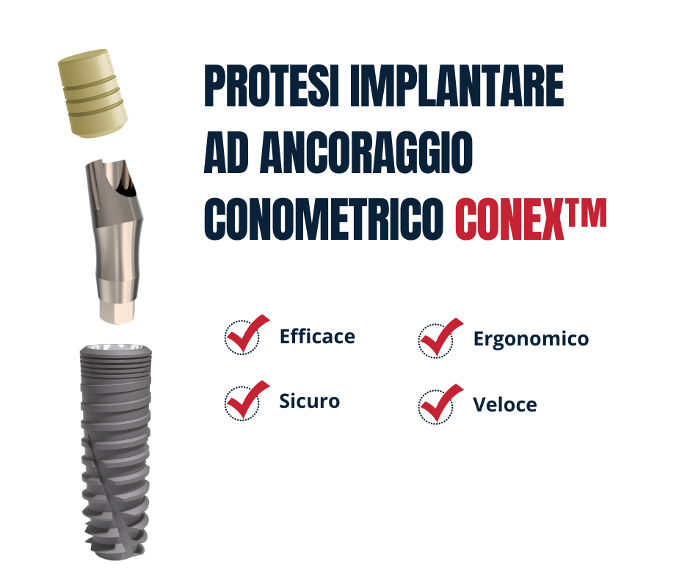In this article you will find a focus on tapered prosthetics, going through its features, delving into its advantages and why it is a high-performance technique. Enjoy your reading!
Summary
What is cone-anchored implant prosthesis?
Conometric anchorage is a method of attaching the prosthesis to the abutment, based on a very high-precision mechanical interface between the abutment and the prosthesis. Unlike traditional prostheses, which use cements or screws to anchor to the implant, conometrical prostheses are joined to the implant by precise and stable prefabricated components.
This anchoring system is based on a conical structure, known as the primary taper, which is an integral part of the prosthetic component. The denture includes a conometric counterpart, the coping, which fits snugly over the primary cone of the implant abutment.
The conometric connection provides excellent and precise mechanical stability, keeping the prosthesis firmly in place during all oral functions. In addition, when necessary, it can be removed by the dentist quickly and easily, ensuring proper maintenance and health of the peri-implant tissues.
This anchoring system is based on a conical structure, known as the primary taper, which is an integral part of the prosthetic component. The denture includes a conometric counterpart, the coping, which fits snugly over the primary cone of the implant abutment.
The conometric connection provides excellent and precise mechanical stability, keeping the prosthesis firmly in place during all oral functions. In addition, when necessary, it can be removed by the dentist quickly and easily, ensuring proper maintenance and health of the peri-implant tissues.
The advantages of conometric prosthesis
The conometric prosthesis is distinguished by several advantages over other prosthetic options, including:
- improved stability. The tapered connection ensures that the prosthesis remains firmly in place, preventing unwanted movement during use;
- The absence of holes. The tapered prosthesis eliminates the need for visible attachment screws, improving aesthetics and function with a more natural appearance;
- comfort. Conometrically anchored prostheses are designed to precisely fit the patient's oral structure;
- improved functionality. Because of the stability provided by this connection, the prostheses allow optimal and more natural function during chewing and phonation;
- ease of cleaning. Prostheses with tapered anchorage promote better oral hygiene due to the absence of bacterial infiltration between the primary and secondary components. In fact, the dentist can easily insert and remove the prosthetic element for cleaning and routine maintenance;
- preservation of bone. The absence of screws or cements at the interface between the abutment and prosthetic structure reduces the risk of complications such as inflammatory processes in soft tissues, directly contributing to the preservation of bone levels in the long term.
ConEx™ P&P Prosthetic Prospective: the ultimate solution for aesthetic and functional high-performance prosthetics
ConEx™ P&P Prosthetic Prospectiverepresents the most comprehensive, effective and safe system for the fabrication of dental restorations with high esthetic and functional value developed by BioService.
This extensively proven system offers an ideal solution for implant-anchored fixed prosthetics. Retention based on Morse Cone Coupling ensures reliable, precise and predictable fixation, providing an aesthetic result comparable to cemented frameworks, but with ease of removal during maintenance sessions by the dentist.
This extensively proven system offers an ideal solution for implant-anchored fixed prosthetics. Retention based on Morse Cone Coupling ensures reliable, precise and predictable fixation, providing an aesthetic result comparable to cemented frameworks, but with ease of removal during maintenance sessions by the dentist.

The advantages of ConEx™ P&P are:
Contact us for more details about the ConEx™ connection, its benefits of conometric prosthesis, and keep following us to find out about upcoming insights!
- Zero risk of submucosal cement residue;
- Zero risk of unscrewing or fracture of the prosthesis holding screws;
- No infiltration of biological fluids between the various components;
- Absence of holes for screw access;
- Significantly reduced prosthesis application and removal times.
Contact us for more details about the ConEx™ connection, its benefits of conometric prosthesis, and keep following us to find out about upcoming insights!

